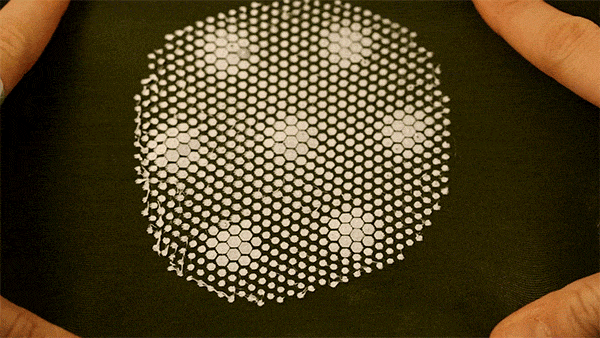Printing on fabric might be a familiar trick, but adding stretch into the equation gives our fabric prints the ability to reconstitute themselves back into 3D. That’s exactly what [Gabe] has accomplished; he’s developed a script that takes open 3d meshes and converts them to a hexagonal pattern that, when 3D-printed on a stretched fabric, lets them pop into 3D upon relaxing the fabric.
[Gabe’s] algorithm first runs an open 3D surface through the “Boundary-First Flattening Algorithm,” which gives [Gabe] a 2D mesh of triangles. Triangles are then mapped to hexagons based on size, which produces a landscape of 2D hexagons. Simply printing this hexagonal pattern onto prestretched fabric defines the shape of the object that will surface when the fabric is allowed to relax. As for how to wrap our heads around the mapping algorithm, as [Gabe] explains it, “The areas that experienced the most shrinkage in the flattening process should experience the least shrinkage when the fabric contracts after printing, and the regions that experienced little to no shrinkage in the flattening process should contract as much as possible in the fabric representation.”
If that seems tricky to visualize, just imagine taking a cheap halloween mask and trying to crush it flat onto a table. To smush it perfectly flat, some sections need to stretch while others need to shrink. Once flat though, we can simply keep stretching to remove all the sections that needed to shrink. At this point, if our material were extremely elastic, we could simply let go and watch our rubber mask jump back into 3D. That’s the secret behind [Gabe’s] hexagonal pattern. The size and spacing of these hexagons limit the degree to which local regions of the fabric are allowed to contract. In our rubber mask example, the sections that we stretched out the furthest have the most to travel, so they should contract as much as possible, while the sections that shrank in the initial flattening (although we kept stretching until they too needed to stretch) should shrink the least.
We’ve seen some classy fabric-printing tricks in the past. If you’re hungry for more 3D printing on fabric, have a look at [David Shorey’s] flexible fabric designs.
Thanks for the tip, [Amy]!
















This is extremely clever. I definitely want to try this out. I’ve used that flattening algorithm to make UV maps for 3d objects before, but I’d never think to use it like this.
Very cool. Wheres the video. Theres an Instagram video from the linked site comment.
Now replace “fabric” with “steel mesh”, and replace “plastic” with “concrete”, and you get yourself a method to create complex curved light and strong surfaces of prestressed concrete. Architects should go crazy on this.
Stretchy steel?
Every material is stretchy; steel with follows in a certain range hook’s law https://en.wikipedia.org/wiki/Hooke%27s_law
Sure – but not stretchy enough for this. If it was then it wouldn’t be much use for reinforcing concrete where the strength of the steel under tension complements the concrete which is lacking in just this area.
That’s why steel springs are in the shape of coils. You could make a grid of coil springs welded at their intersection and stretch them just like this fabric. I would think you’d want to have a curved part of your building stressed to be more curved not more flat but I guess you could do that too.
Holy shit this is cool. Would be cool way to make masks.
And Brassieres…
It wouldn’t be very good for a bra. A bra needs to maintain its shape, a bit of stretch makes them more generic, and more comfortable for breasts which fluctuate in size, but too much stretch and the garment may as well be a t-shirt.
All righty then…
a codpiece.
B^)
Haha. I suspect the better bet for both bra and codpiece would be a custom printed plastic object made with the exact measurements of the wearer in mind.
The title is missing a T, isn’t it?
I believe it is, yes. Fixed!
OLED screens could benefit from this. We could use this fabric as a flexible “back board” for the screen.
For example – Imagine an OLED screen that needs to roll up into a tube when stored.
When in use – the fabric could stiffen so that the OLED screen becomes a flat viewable surface.
That is neat as hell and super clever.
Agreed, and the shop has lots of cool things I’ll be buying for gifts for family. Generative designed jewelry and jigsaw puzzles, oh my!